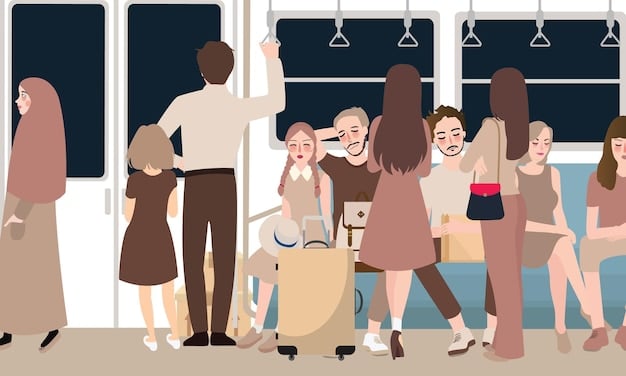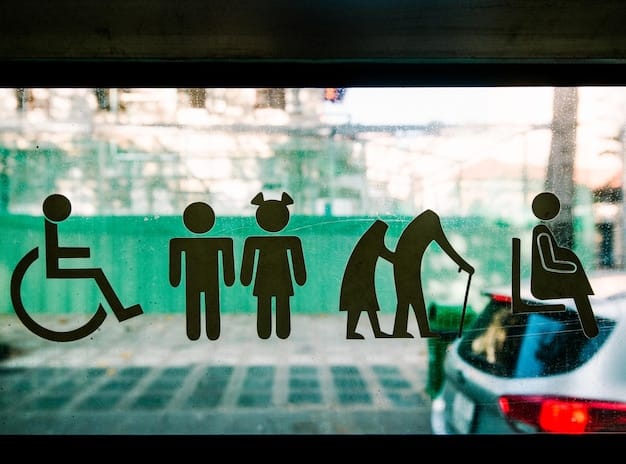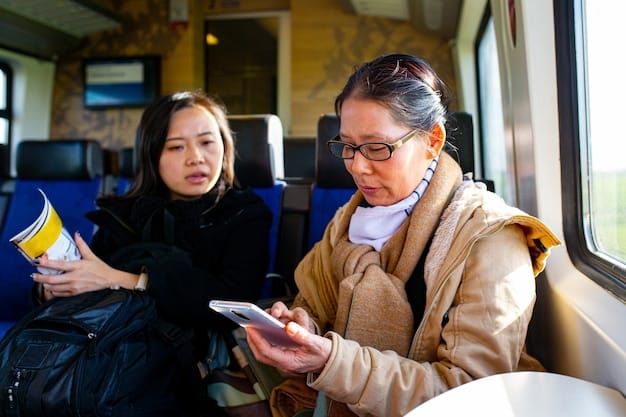Navigating Japan’s Rails: A 2025 Guide to Train Etiquette for US Commuters

Understanding Japanese train etiquette for US commuters in 2025 is crucial for a smooth and respectful travel experience, encompassing quietness, cleanliness, and consideration for fellow passengers, ensuring harmony within the efficient Japanese railway system.
Embarking on a journey through Japan in 2025? As a US commuter, you’re likely accustomed to certain norms on public transport. However, Japanese train culture operates under a unique set of unspoken rules. This guide, **understanding Japanese train etiquette**, will equip you with the knowledge to navigate the rails like a seasoned local, ensuring a respectful and enjoyable experience.
Understanding Japanese Train Etiquette: A Guide for US Commuters in 2025
Stepping onto a Japanese train can feel like entering a different world. The calmness, the cleanliness, and the almost palpable sense of order are often a stark contrast to the bustling, sometimes chaotic, atmosphere of public transport in the United States. But don’t be intimidated! With a little preparation and awareness, you can easily adapt and demonstrate your respect for Japanese culture.
The Importance of Observation
One of the best ways to learn is by watching. Pay attention to how Japanese commuters behave on the train. Notice their posture, their volume, and their interactions with others. This simple act of observation can provide invaluable insights into the nuances of train etiquette.
Avoiding Common Pitfalls
Many etiquette blunders stem from simple unawareness. This guide will highlight some of the most common mistakes made by foreign visitors and provide practical tips for avoiding them. Remember, showing respect is key to a positive intercultural experience.
- Loud Conversations: Keep your voice down. Avoid talking loudly on your phone or engaging in boisterous conversations.
- Eating and Drinking: While not always prohibited, eating and drinking are generally discouraged on commuter trains, especially during peak hours.
- Blocking Doorways: Be mindful of your position and avoid blocking the doorways, especially when the train is crowded.
By understanding and adhering to these guidelines, you’ll not only avoid causing offense but also contribute to the harmonious atmosphere of the Japanese railway system. Remember, respect and consideration are the cornerstones of Japanese train etiquette.

The Golden Rule: Silence is Golden
Perhaps the most noticeable aspect of Japanese train etiquette is the prevailing silence. While complete silence isn’t always expected, a hushed and respectful atmosphere is highly valued. This stems from a deep-rooted cultural emphasis on minimizing disruption and respecting the personal space of others.
Phone Etiquette: A Balancing Act
Using your phone on the train requires careful consideration. Talking on the phone is generally considered impolite, as it disrupts the quiet atmosphere. Instead, opt for texting, emailing, or browsing the internet.
Headphones and Volume Control
If you’re listening to music or watching videos, ensure your headphones are securely in place and the volume is low enough that others cannot hear it. Leaky headphones can be a major source of annoyance for fellow passengers.
It is better to keep your phone silent at all times to not disturb nearby people. If you are expecting an urgent call, try to step outside of the train so you are not disturbing others.
Embracing the culture of quietness on Japanese trains demonstrates respect for your fellow passengers and contributes to a more pleasant travel experience for everyone. It’s a small gesture with a significant impact.
Mind Your Belongings: Space and Consideration
In the often-crowded confines of a Japanese train, being mindful of your belongings is essential. This means taking steps to minimize the space you occupy and ensuring your luggage doesn’t inconvenience other passengers. The key is to consider how your actions impact those around you and to strive to be as unobtrusive as possible.
Luggage Placement: A Strategic Approach
If you’re traveling with large suitcases or backpacks, utilize the overhead racks or designated luggage areas whenever possible. Avoid placing your luggage in the aisle or on empty seats, as this can obstruct the flow of traffic and prevent other passengers from sitting.
Backpack Awareness: A Matter of Space
When standing on a crowded train, be particularly mindful of your backpack. Consider taking it off and holding it in front of you or placing it on the floor between your feet. This prevents it from bumping into other passengers and taking up unnecessary space.
It might be hard to imagine wearing a backpack on your frontside, but doing so will prevent others from getting accidentally hit with your luggage. Holding it prevents the wearer from getting backpacked as well so this is a win-win.
- Minimize Obstruction: Ensure your belongings don’t block doorways or impede the movement of other passengers.
- Utilize Available Space: Take advantage of overhead racks and designated luggage areas.
- Maintain Awareness: Be conscious of how your belongings impact those around you.
By practicing thoughtful luggage etiquette, you contribute to a more comfortable and efficient travel experience for everyone on board. It’s a simple way to show respect and consideration for the shared space.
Priority Seating: Understanding the System
Japanese trains often feature “priority seats,” designated for elderly, disabled, pregnant women, or passengers with small children. These seats are typically located at the end of each car and are clearly marked with signage. Understanding the rules and etiquette surrounding priority seating is crucial for avoiding cultural faux pas.
Offering Your Seat: A Gesture of Kindness
If you’re sitting in a priority seat and a passenger who appears to need it boards the train, it’s customary to offer your seat. This is considered a polite and respectful gesture. Even if no one appears to need the seat, be prepared to offer it if someone does.
Avoiding Assumptions: Respecting Individual Needs
It’s important to avoid making assumptions about who needs a priority seat. Some disabilities are not immediately visible. If you’re unsure, it’s always best to err on the side of caution and offer your seat.

It’s not just offering your seat, but even if there are none of the people with disabilities, you can elect to sit elsewhere so others have more space to sit. Priority seating is more of a suggestion to not occupy it, unless it is really needed by the occupier.
Understanding and adhering to priority seating etiquette demonstrates compassion and respect for those who may need assistance. It’s a simple yet meaningful way to contribute to a more inclusive and considerate society.
Boarding and Alighting: Smooth Transitions
The process of boarding and alighting a Japanese train is typically a smooth and orderly affair. This is due to a combination of efficient design, clear signage, and a cultural emphasis on respecting personal space and minimizing disruption. By understanding and following the proper etiquette, you can ensure a seamless transition on and off the train.
Forming an Orderly Queue: Patience and Respect
When waiting to board the train, form an orderly queue in front of the designated boarding area. Avoid pushing or shoving, and allow passengers to disembark before attempting to board. Patience and respect are key.
Allowing Passengers to Disembark First
Always allow passengers to disembark the train before attempting to board. This prevents congestion and ensures a smoother flow of traffic. Stand to the side of the doorway and wait for everyone to exit before stepping onto the train.
Following the proper boarding and alighting etiquette ensures a smoother and more efficient travel experience for everyone. It’s a demonstration of respect for fellow passengers and a contribution to the overall harmony of the Japanese railway system.
Other Considerations: Beyond the Basics
Beyond the core etiquette guidelines, there are a few other considerations that can help you navigate the Japanese train system with grace and respect. These include being mindful of cleanliness, avoiding disruptive behaviors, and being prepared for potential delays.
Maintaining Cleanliness: A Shared Responsibility
Japanese trains are typically very clean, and maintaining this cleanliness is a shared responsibility. Avoid littering, and dispose of any trash in the designated receptacles. Refrain from placing your feet on the seats or leaving any mess behind.
Avoiding Disruptive Behaviors
Certain behaviors are considered disruptive and should be avoided on Japanese trains. These include talking loudly, playing loud music, eating messy foods, and engaging in overly affectionate displays. Be mindful of your surroundings and strive to minimize any potential disturbances.
- Respect Personal Space: Avoid crowding or bumping into other passengers.
- Be Prepared for Delays: While rare, train delays can occur. Be patient and follow the instructions of the train staff.
- Learn Basic Japanese Phrases: Knowing a few basic Japanese phrases can be helpful for asking for directions or assistance.
By being mindful of these additional considerations, you can further enhance your understanding of Japanese train culture and ensure a respectful and enjoyable travel experience. Remember, a little awareness goes a long way.
Embracing Cultural Differences: A Positive Experience
Ultimately, understanding Japanese train etiquette is about embracing cultural differences and demonstrating respect for local customs. By being mindful of your behavior and striving to adhere to the unspoken rules, you can contribute to a more positive and harmonious travel experience for everyone.
The Value of Observation and Adaptation
Pay attention to how Japanese commuters behave on the train and adapt your own behavior accordingly. This shows respect for local customs and demonstrates your willingness to learn and understand. Don’t be afraid to ask for help or clarification if you’re unsure about something.
The Rewards of Cultural Sensitivity
By being culturally sensitive and respectful, you’ll not only avoid causing offense but also create opportunities for meaningful interactions with locals. You’ll find that Japanese people are generally very welcoming and appreciate visitors who make an effort to understand their culture.
Being culturally sensitive and showing a willingness to adapt can greatly enrich your travel experience. It is a sign of respect to the local culture and shows that you are trying to adapt as well.
| Key Point | Brief Description |
|---|---|
| 🤫 Silence | Maintain a quiet environment, avoiding loud conversations and phone calls. |
| 🎒 Belongings | Be mindful of luggage and backpacks, utilizing racks and avoiding obstructions. |
| 💺 Priority Seats | Understand and respect priority seating for elderly, disabled, or pregnant passengers. |
| 🚶 Boarding/Alighting | Queue orderly and allow passengers to exit before boarding. |
FAQ
▼
While not strictly forbidden, eating on commuter trains, especially during rush hour, is generally discouraged. On long-distance trains, like the Shinkansen, it is more common and accepted.
▼
Talking on your cell phone is considered impolite on most Japanese trains. It’s best to text, email, or browse the internet instead. If you must take a call, step into the train vestibule.
▼
Utilize the overhead racks or designated luggage areas whenever possible. If these are full, keep your luggage close to you and avoid blocking the aisle or doorways.
▼
If you see an elderly, disabled, pregnant, or passenger with a small child, it’s customary to offer your seat. Even if no one appears to need it, be prepared to offer it if someone requests it.
▼
Train delays are rare in Japan, but they can happen. Stay calm, listen for announcements, and follow the instructions of the train staff. Patience is key in such situations.
Conclusion
By learning to navigate the complexities described above, you will be more prepared than other inexperienced visitors. Ultimately, **understanding Japanese train etiquette** boils down to respect, consideration, and a willingness to adapt to local customs. As a US commuter in 2025, embracing these guidelines will not only ensure a smoother travel experience but also demonstrate your appreciation for Japanese culture, paving the way for more meaningful interactions and a truly enriching journey.





